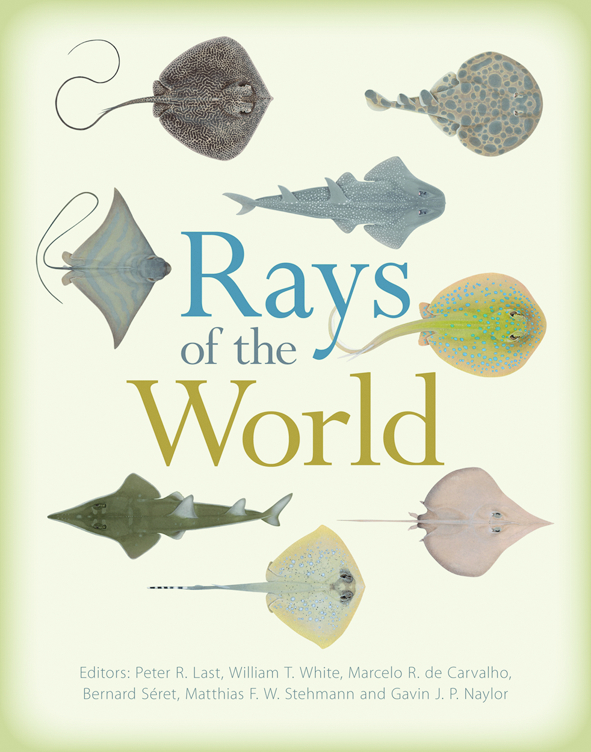Studying a little known group of fish
The iconic group of fish known as rays—stingrays, skates, sawfish, guitar fish, and devil rays—are some of the biggest and least known fish in the ocean.

The research underpinning Rays of the World proved challenging as many of the book's 633 species of rays were previously unknown to science, meaning they have not been on anyone's radar for research and conservation.
Around 20 per cent of the world's rays are in danger, including 10 critically endangered species, 30 endangered species, and 72 vulnerable species.
Without intervention, some species may soon be extinct, including Tasmania's largest endemic fish, the Maugean Skate.
Searching natural history collections, in the wild and fish markets
The book's authors worked on the project for five years, searching natural history collections and museums around the world, including CSIRO's Australian National Fish Collection (ANFC) in Hobart, as well as searching for rays in the wild and at remote fish markets.
Some species are known only from specimens squashed into preserving jars. Other species that researchers had believed they knew fairly well turned out to be a complex of six or seven different species after more detailed investigation.
DNA analyses provided new insights, allowing the researchers to recognise not just new species but whole new genera and families.
The first illustrated guide to the world's rays
The book, Rays of the World, was made possible because of collections such as our ANFC where scientists can compare specimens, carry our further analyses and provide reference material for use by professional illustrators.
The book enables readers to gain a better understanding of the rich diversity of rays and promote wider public interest in the group.
One of most widespread and diverse groups of fishes, rays play vital ecological roles in the world's marine and freshwater environments. They can be predators, scavengers and prey and are harvested for many uses, including food, leather goods and medicine. The barbs of stingrays and saws of sawfishes have even been used as traditional knives and weapons.
The rays of the world range in size from seven-metre-wide mantas and seven-metre-long sawfish to the tiny electric sleeper ray, which reaches maturity at only eight to ten centimetres in length.
Rays are not typically aggressive to humans, but the stings of stingrays and sharp saws of sawfishes can cause injuries if these animals are mishandled or startled.
Rays of the World was published by CSIRO Publishing and beautifully illustrated with paintings of each species, reflecting the difficulty of photographing preserved specimens or rare rays in the wild.
The book was funded by the US National Science Foundation, CSIRO Oceans and Atmosphere and the ANFC.
Studying a little known group of fish
The iconic group of fish known as rays—stingrays, skates, sawfish, guitar fish, and devil rays—are some of the biggest and least known fish in the ocean.
The research underpinning Rays of the World proved challenging as many of the book's 633 species of rays were previously unknown to science, meaning they have not been on anyone's radar for research and conservation.
Around 20 per cent of the world's rays are in danger, including 10 critically endangered species, 30 endangered species, and 72 vulnerable species.
Without intervention, some species may soon be extinct, including Tasmania's largest endemic fish, the Maugean Skate.
Searching natural history collections, in the wild and fish markets
The book's authors worked on the project for five years, searching natural history collections and museums around the world, including CSIRO's Australian National Fish Collection (ANFC) in Hobart, as well as searching for rays in the wild and at remote fish markets.
Some species are known only from specimens squashed into preserving jars. Other species that researchers had believed they knew fairly well turned out to be a complex of six or seven different species after more detailed investigation.
DNA analyses provided new insights, allowing the researchers to recognise not just new species but whole new genera and families.
The first illustrated guide to the world's rays
The book, Rays of the World, was made possible because of collections such as our ANFC where scientists can compare specimens, carry our further analyses and provide reference material for use by professional illustrators.
The book enables readers to gain a better understanding of the rich diversity of rays and promote wider public interest in the group.
One of most widespread and diverse groups of fishes, rays play vital ecological roles in the world's marine and freshwater environments. They can be predators, scavengers and prey and are harvested for many uses, including food, leather goods and medicine. The barbs of stingrays and saws of sawfishes have even been used as traditional knives and weapons.
The rays of the world range in size from seven-metre-wide mantas and seven-metre-long sawfish to the tiny electric sleeper ray, which reaches maturity at only eight to ten centimetres in length.
Rays are not typically aggressive to humans, but the stings of stingrays and sharp saws of sawfishes can cause injuries if these animals are mishandled or startled.
Rays of the World was published by CSIRO Publishing and beautifully illustrated with paintings of each species, reflecting the difficulty of photographing preserved specimens or rare rays in the wild.
The book was funded by the US National Science Foundation, CSIRO Oceans and Atmosphere and the ANFC.
